For most of us, the pandemic of 2020 has transformed our lives. Commutes, gone. Offices, gone. Drop-offs at school, gone. Sadly, too often loved ones gone as well.
But one of the most remarkable aspects of the COVID-19 pandemic for the members of the IBEW was how often and how often we were called on to maintain stability and provide the foundation that kept life and the rest of the economy from collapsing.
For the last 12 months, our members have made it possible for millions of people to work and study from home. The data centers that made billions of video calls possible were built with our hands. The hospitals, permanent and temporary, were built with our hands. Overnight, the 100-year-old model of where and when power is consumed changed completely — offices never lit up, houses never went dark — and we handled it without skipping a beat.
Someone out there coined the term, "The International Brotherhood of Essential Workers," and it stuck.
It has been a full year since much of North America saw offices and schools shutter. For most of the members of the IBEW, work didn't stop. Our jobs changed. Policies changed. The people we work with changed along with the shape of daily life. But it was still our work, and we did it with pride and a renewed commitment to safety.
And we did the unhappy, necessary work at the darker edges of the pandemic. We built the field hospitals in parking lots and fairgrounds and convention centers. We wired the temporary morgues because it had to be done and we were the ones able to do it.
When work needed to be done, we stepped up. We slept in trailers on parking lots outside grid operation centers.
When we traveled hundreds of miles for mutual assistance work after hurricanes or major storms, we slept in our trucks. We ate alone.
We did it because our families depended on us. Our neighbors depended on us. We did it because it was our job.
"For the past year, I've heard stories every day that make me so proud not only to lead this great union, but just to be a member of it," said International President Lonnie R. Stephenson. "When our communities and our countries called on us, we've been there to answer it. We've taken care of one another and our families through one of the most difficult years imaginable.
"But now is not the time to let off," he said. With new, more transmissible variants being seen, the race is on to complete a mass vaccination campaign that is just barely underway.
"Take care of yourself, your family and your brothers and sisters on the job. Follow protocols. Wear a mask. Stay socially distant. Wash your hands regularly," Stephenson said.
A year is still soon to declare victory. It is only a time to take stock.
"We kept our communities warm, powered up and connected. We helped get our countries to where an end is in sight," he said. "Now, let's finish the job."
The following stories are just a few examples of IBEW brothers and sisters working through, adapting and staying safe in a calamitous year.
Members Answered Call for More Hospitals
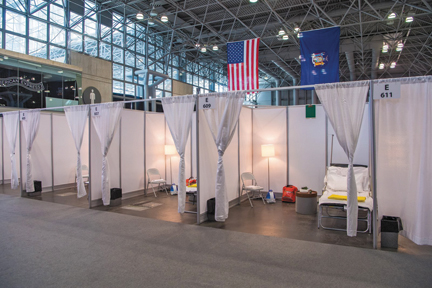
|
|
Members across North America built temporary hospitals in the spring of 2020. One of the largest was built by New York Local 3 in the Jacob K. Javits Convention Center, which served more than 1,000 patients.
|
As the first wave of the pandemic rapidly spread across the country last spring, a new phrase entered the North American consciousness: bend the curve.
Astonishing pictures were coming in from around the world showing COVID patients dying in hospital hallways as cases far surpassed available beds.
Bending the curve meant slowing the spread so that even if there were just as many cases in the end, there were never too many at once for hospitals to handle.
But the other side of that equation meant expanding hospital capacity, and IBEW members built field hospitals from St. Louis to Albuquerque to a Reno parking garage. Vacant convention centers were transformed into field hospitals by members alongside the Army Corps of Engineers in New York, Detroit, Chicago, Boston and Washington.
According to an analysis by NPR, the Army Corps of Engineers coordinated and funded at least 30 facilities. States announced dozens more, though there is no clearinghouse that keeps track of exactly how many were built.
One of the largest and, sadly, most used, was a 1,900-bed facility in the Jacob Javits Convention Center in Manhattan.
New York City Local 3 members began work in late March; within a week, overflow patients from New York's besieged hospitals began to fill its halls. By the time the first wave subsided in early summer, more than 1,000 patients found the care they needed.
Local 3 members worked on three other field hospitals, two on Long Island and a third in Westchester County north of the city.
The field hospital at the Wisconsin State Fairgrounds built by Milwaukee Local 494 members in April treated more than 170 patients, said Local 494 Business Manager Dean Warsh. It was converted into an outpatient treatment clinic in the fall after the state's hospitals caught up and is being repurposed as a vaccination hub.
Even though many of the facilities ultimately went unused, they were seen as a success.
As Michigan Gov. Gretchen Whitmer said last spring, "These 1,000-bed alternate care sites are not necessary; they're not filled. Thank God."
Hydro Workers Hunker Down
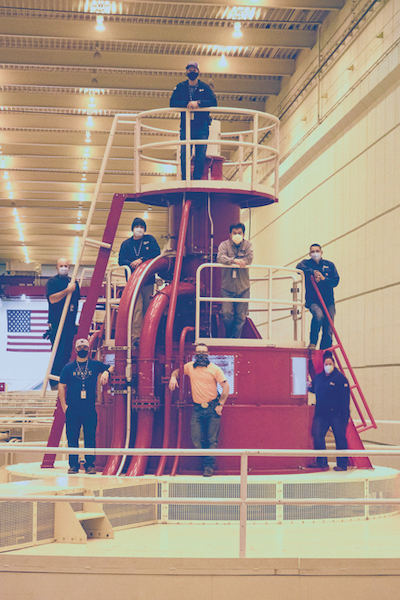
|
|
Some of the Seattle Local 77 members who sequestered last fall at the Columbia River's Priest Rapids Dam to protect their worksite from a COVID-19 outbreak.
|
Months before workers were called on to sequester at the Priest Rapids Dam, Seattle Local 77 bargained the terms of wages and working conditions — just in case.
"We were ahead of the game," said Business Representative Brian Gray, whose central Washington territory includes Priest Rapids and a second Columbia River dam operated by the Grant County PUD.
But there was still a learning curve last October, the day an employee tested positive for COVID-19. Supervisors scrambled to call in volunteers and run out for snacks, cots and sleeping bags.
Management ironed out the kinks as the first team of IBEW electricians, mechanics and operators hunkered down for eight days and nights, followed by a three-day relief crew.
When the virus forced another 24/7 stay in December, it was shop steward Mike Bradshaw's turn. Preparations included a clean shave, as he and his bearded brothers traded everyday masks for closer-fitting N95s.
A bonus was that they ate like kings, enjoying three hot meals a day from a popular barbecue joint. "I think most of us gained weight," Bradshaw said with a chuckle.
Sequestration came later to Priest Rapids than many other utilities. Early on, grid operators from New York to California clustered for shifts as long as four weeks.
At some U.S. nuclear plants, reactor operators lived onsite in RVs. Mark MacNichol, international representative in the Utility Department, said the Nuclear Regulatory Commission worked with the industry and unions on temporary procedural changes — cooperation that was deeply appreciated.
At Priest Rapids, gratitude is mutual.
"I can't say enough positive things about the union's willingness to engage on what is a life-essential service mission," said Kevin Nordt, PUD general manager and CEO. "We can't keep our customers' lights on without our workers."
In Ontario, Frontline Healthcare Workers
Sacrifice for Little in Return
About 265 of Lincoln, Ontario, Local 636 members define what it means to be on the frontline.
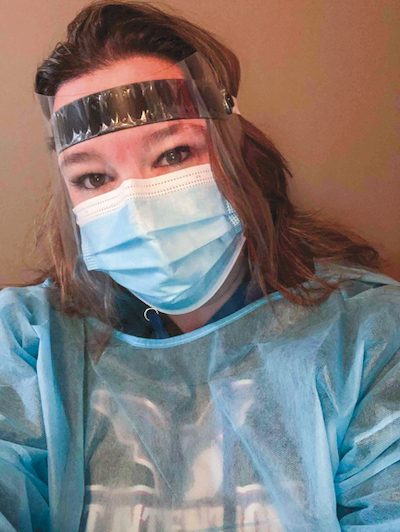
|
|
Local 636's Melissa Cousineau-Ellis was one of many Simcoe developmental support employees who went above and beyond this year.
|
They are personal support workers employed by Empower Simcoe in the central Ontario city of Orillia and at Assisted Living Southwestern Ontario, just across the border from Detroit. They work in private homes and long-term care facilities caring and cleaning for patients suffering from permanent disabilities — Canadians most at risk of contracting COVID-19.
"I don't know if I can give them enough praise," said Business Manager Domenic Murdaca, whose members live throughout the province. "I try to give them support, but I can't thank them enough for the tasks that they're doing."
Despite their extraordinary work over the past year, those Local 636 members have not received the respect they deserve.
Murdaca noted that even before the pandemic, the Progressive Conservative-controlled provincial government passed legislation that limited employees of publicly funded corporations like Simcoe to just a 1% annual raise. The IBEW and other Canadian unions are challenging the law in court, but a ruling is months away.
Some of the Local 636 members working for Simcoe did not qualify for additional pandemic pay because it required employees to spend at least 50% of their hours directly dealing with patients. Time running essential errands for them — many of whom can't leave their homes — is not rewarded in the same way.
"These Local 636 members are doing some of the most essential work in all of Canada," First District Vice President Thomas Reid said. "The way they're treated by some of our politicians is disappointing, to say the least. Myself and other IBEW leaders will continue to push federal and provincial officials to give them more support."
Murdaca will be among those leaders doing so.
"With the pandemic not getting any better, we're seeing a lot of stress and strain on them," he said. "They are right in the middle of it. They go through hell and we are doing our best to keep up their spirits."
Milwaukee Members Power COVID Research Facility
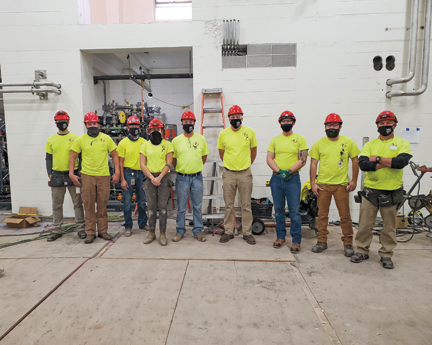
|
|
Milwaukee Local 494 members are powering the expansion of a research facility involved in COVID-19 testing.
|
As the science and research surrounding the coronavirus has progressed over the last year, so has the work of Milwaukee Local 494. Its members joined the ranks of thousands of other IBEW wiremen working on facilities doing groundbreaking research on COVID-19 and helping to outfit facilities for the manufacture of vaccines and testing supplies.
"Our members are proud to be doing their part to rid the world of this deadly disease," said Local 494 Business Manager Dean Warsh. "Their hard work to build the needed laboratory space will help bring this pandemic to an end."
IBEW signatory contractor Preferred Electrical Contractors was tapped in late 2020 to work on a remodel and expansion of Thermo Fisher's East Side Milwaukee facility. Thermo Fisher manufactures ingredients used for the testing of COVID-19 and Preferred Electrical Contractors has the needed expertise in the laboratory and hospital industries. The laboratory buildout involves all new switchgear and control wiring for lab equipment and is employing 8-12 members on any given day. Work on the second phase of the project is expected to wrap up around mid-year.
"This expanded facility will help make the world healthier and safer," Warsh said. "It's Thermo Fisher's partnership with the IBEW that will see this project completed on time and on budget."
From building temporary hospitals to a recent project working with 3M to manufacture critical N95 masks, Local 494 members are part of the growing ranks of IBEW brothers and sisters across North America working to combat the virus. Read more about members from California, Missouri, Michigan, Massachusetts and more who are helping to fast-track vaccine production in January's Electrical Worker.
With Little Backup, IBEW Members Keep the Trains Moving

|
|
Philadelphia Local 2271 members helped keep passengers and freight moving over the past year.
|
COVID-19 hit home in a very real way for Philadelphia Local 2271 President Pearse Kerr, whose son — a journeyman wireman with Philadelphia Local 98 — tested positive for the coronavirus in December, forcing Kerr into a two-week, self-quarantine lockdown.
"It's affected different departments in different ways," said Kerr, the leader of a railroad local with about 120 members who work for Amtrak and several commuter and freight-rail agencies. "Amtrak has been very good with masks, gloves and cleaning supplies, but not a lot of people are taking the rails."
Near non-existent ridership has greatly affected passenger revenues, which has made it harder for companies to hire workers, Kerr said. "Some departments are running on fumes and overtime," he said. "In our engine house, we're supposed to do locomotive inspections every 24 hours, but that's tough because there's only so much you can do if you're short-handed."
Those pressures are familiar to members across the IBEW's Railroad branch, said Director Al Russo.
"Since everything changed last March, our members in passenger, commuter and freight rail have been asked to show up and keep doing their work at great personal risk," he said. "But they've answered that call because they know how critical their jobs are to keeping the U.S. and Canadian economies going strong.
"Whether we're moving essential workers or transporting important freight, our railroad members understand what's at stake and have risen to the challenge of COVID-19," he said.
In the meantime, Russo feels that members should go ahead and register as soon as they can with their local state health agencies to get in line for a COVID-19 shot. "Sometimes you have to be proactive," he said. "I think it's too important to wait for the railroads on this.
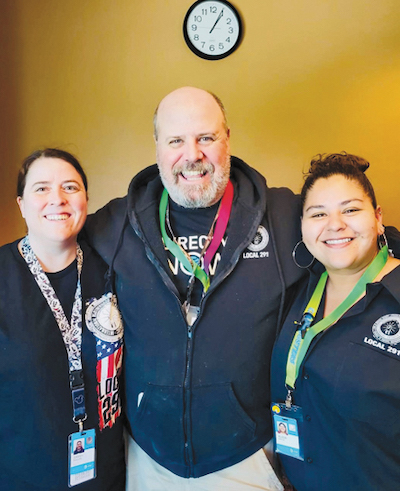
|
|
Many call-center members of Boise, Idaho, Local 291 seamlessly shifted to work-from-home last March.
|
Fielding Customer Calls — Same, but Different
Most days, AT&T's DirecTV call center in Boise, Idaho, is a sea of sound and activity. The 600-plus bargaining unit members from Boise Local 291 field all varieties of customer calls for the satellite giant, and there's a constant hum about the place.
But for the last year, it's been quiet. Last March, as worry about the coronavirus spread, more than half the workers switched to work-from-home virtually overnight. Today, only about 80 representatives work from the building, spaced out among the sea of desks to prevent any spread of the virus by someone unknowingly infected.
"There was no system in place for working from home," said David Mould, a customer service representative and chief steward for Local 291. "Considering how quickly the company had to change the way it did things and set people up with equipment — desktop computers and company cell phones — it's all gone really smoothly."
Senior chief steward Amanda Miller has continued to work from the call center, where the daily routine now involves health screening questions via a phone app, little personal interaction and daily equipment wipe downs, backed up by an industrial supply of sanitizer and face masks.
With most interactions being done remotely, communication has taken extra effort, both within the unit and with supervisors. "It's not the same when you can't be in a room together," Miller said.
For the thousands of customer representatives across the IBEW, it's been the same story. "We have a job to do," Mould said. "Whether it's from home or the office, the need's still there. People have to stay connected.
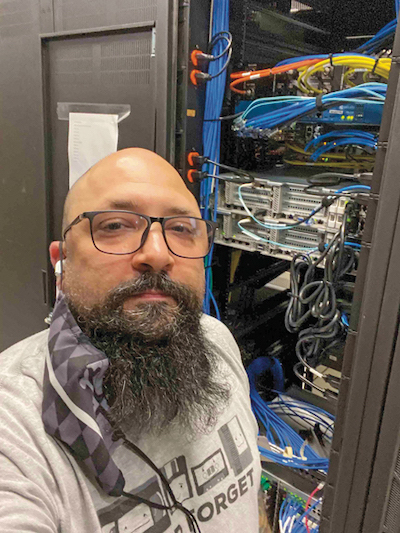
|
|
Washington D.C. Local 1200 member Mike Vedral, an engineer at WBAL-TV in Baltimore.
|
In Baltimore, 'Incredible Team Effort'
Keeps Iconic TV Station On Air
Washington, D.C., Local 1200 member Mike Vedral has worked for 21 years as an engineer for WBAL-TV, the NBC affiliate in Baltimore. Nothing prepared him and his colleagues for the challenges of the last year.
Like members at dozens of local stations across the U.S., early fears of COVID-19 sent them scrambling as they worked with management and other employees to keep the station on the air and transition to remote news broadcasts nearly overnight. WBAL's studios and offices were closed except to essential personnel during the pandemic's early days.
"It was constant stress," Vedral said. "Even when I went home, you worried about what was next."
Vedral said that was especially true in the rush to a remote operation during the first two weeks last March. Anchors suddenly had to read the news from home. Reporters filed reports from the field — sometimes from their cars. Editors had to edit from home. Technicians accustomed to producing a telecast from a studio now had to do so on a laptop.
Engineers and technicians worked on picnic tables under open-air awnings and tents outside the office with a pair of production trucks nearby. Staffers began working in an open-air garage when weather turned cool.
Some anchors and staffers have returned to the building while observing social distancing, but many of the challenges remain, Vedral said.
"That was an incredible team effort by everyone at the station," he said. "Union members, nonunion employees, all the way up to corporate. We could not have done this without the help of everyone down the line."
"So many of our Broadcast members have adapted quickly to this new reality over the past year. It's been a struggle at times, but they're true professionals and they've proven their value many times over," said Broadcasting and Telecommunications Director Robert Prunn.
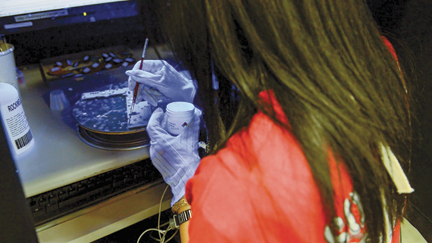
|
|
Manufacturing jobs looked different before COVID-19. Today, masks, gloves and temperature checks are standard for Local 1362 members at Collins Aerospace.
|
No Slow-Down for IBEW's Manufacturing Members
The roughly 1,000 bargaining unit members at Collins Aerospace in Cedar Rapids, Iowa, produce highly specialized communications equipment for commercial and military aircraft.
So, when COVID-19 began its rapid spread around the globe last March, no one at the Raytheon-owned manufacturer thought for a second about shutting down the operation. The jobs the members of Cedar Rapids Local 1362 do, and the equipment they build, are too critical to let the plant sit idle.
They needed a plan, and they needed it fast.
"The early days were tough," said Local 1362 Business Manager Shelley Parbs. "No one could get enough masks and sanitizer, and we were no different. They put distancing in place where it was possible and allowed a lot of flexibility when it came to shifts, breaks and lunches."
Things got a lot better, she said. Today, workers do a daily self-assessment and temperature checks and face masks — or face shields for people with certain medical conditions — are required. Distancing is still followed, and that flexibility allows concerned workers to choose shifts where they won't come into contact with as many people or to skip lunch and take that time at the end of the day.
For the most part, the measures have worked. Parbs said one member went to the hospital early on, but she's heard of no serious cases since. "The work we do is critical to the economy and national security. We were always going to make it work."
"Our manufacturing members have really stepped up across the IBEW," said Manufacturing Director Randy Middleton. "We've met this pandemic head-on and kept the lines running.

|
|
Construction slowed briefly in the early days of the pandemic, but — with many new safety rules — it has roared back in most places, including at the Vogtle nuclear plant in Georgia.
|
'Temporary Normal' on Construction Sites
After Pandemic's Fearful Early Days
As 2020 began, construction in North America was in a yearslong boom with walkthroughs and open calls in many locals.
The pandemic was like an earthquake, said Construction and Maintenance Director Mike Richard.
"It was scary, and it was unclear how much damage there would be, but the foundations were strong," he said. "Wherever governments allowed it, work came back quickly or even picked up."
"There was definitely a learning curve," said Augusta, Ga., Local 1579 Business Manager Will Salter.
The largest construction project in North America, the Vogtle nuclear power plant, is in his jurisdiction. The changes to safeguard trades workers at Vogtle mirrored the changes on construction sites everywhere, just on a larger scale.
In April, Southern Company converted 3-4 acres of parking lots into an onsite medical complex with trailers and tents to battle an outbreak among the 6,000 trade workers, including 1,500 IBEW members. Anyone with symptoms or who felt sick was tested and sent home — with 8 hours a day pay — for 14 days.
"They could have treated it like any other sickness; what they offered was generous, but not different from what everyone else was doing," Salter said. "At the time, we were worried and needed to know there was some security out there."
Nearly 500 workers took a voluntary layoff. But, Salter said, most came back within a few weeks. They arrived at a transformed jobsite: masks were required. Plexiglass dividers were in all the break rooms. The buses on the massive site were stopped.
Vogtle did not adopt some of the practices that became popular elsewhere like issuing workers RFID chips that chirp if people get too close for too long, or changing punch lists so that crews would be smaller and less dense. Some business managers reported fewer fights with contractors over restrooms and hygiene facilities on smaller jobs.
Salter said he doesn't see many of the practices outliving the crisis.
"This is the temporary normal. The company and contractors are doing their best and the members are doing their best," Salter said. "We would love to see this gone by winter and next year we can run around the job without masks. It'd be great if it was gone by summer. It gets awfully hot down here.
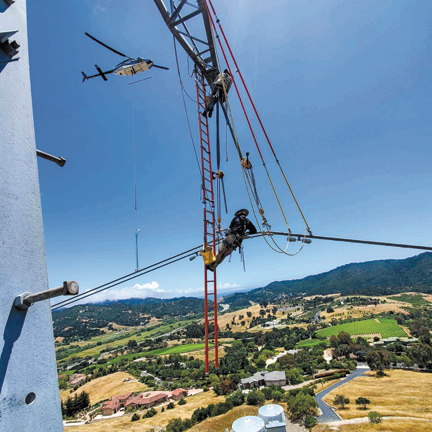
|
|
Even linework had to change this past year, primarily in how people got to the job and where they would stay during emergency work.
|
Linework was Made for Social Distancing,
but Challenges Remain
Linework, while always a dangerous job, would appear to be somewhat immune from the risks of interaction that COVID-19 creates.
It's often preformed, outside, alone in a lift, up in the air, deep in the woods or high in the mountains.
But even outside linework has been changed by the pandemic, said Utility Director Donnie Colston, because you still have to get there. You still work on a team.
"The biggest change is the isolation of the crews," Colston said.
The utility truck is almost always home to a single person. No more mustering at a single dispatch. Crews meet at substations or even dispatch straight from home. And the crew you work with stays the crew you work with. There's no overlap with others.
"The whole point was to limit exposure," he said.
The difference was especially marked during mutual assistance calls after disasters, often hurricanes.
"Historically they would have a gym of a local school with cots to all sleep together, share the same showering facilities, same cafeteria. They would all be together," Colston said. "Now you have to limit the number of people working together and make sure they don't interact with other crews from other companies."
One person to a room became the norm, a change eagerly welcomed by the hotel and motel industry, which was hit hard when tourism and business travel evaporated.
Colston joined weekly calls with the owners of investor-owned utilities through the Edison Electrical Institute to discuss best practices and policies.
"What we have learned is that we didn't miss a beat in an emergency," Colston said. "There were very few COVID cases once we got the safeguards in place. Our partners and our members have done a really good job of protecting themselves and getting the job done.